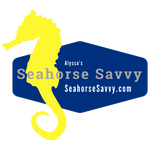Training Your Seahorse to Feed at a Feeding Station

What is a Seahorse Feeding Station?
A feeding station is any bowl shape object used to hold food and target feed your seahorses. We highly recommend using a feeding station in your seahorse display aquarium. Utilizing a feeding station will help keep your seahorses well fed, minimize waste, and keep your aquarium significantly cleaner long term.

Photo credit: Lisa Bacchus
What you can use as a Feeding Station
You can use any bowl shape object safe to go into a saltwater aquarium as a feeding station. Shells, artificial bowl shape coral decorations, glass bowls are some items you can use as a seahorse feeding station. Our very first seahorse feeding station was a spiny oyster shell. Clam shells are great for this too if you are able to get a hold of one. Shells are great for those who prefer a more natural look.
How to get your Mysis Shrimp into the Feeding Station
Thaw your frozen Mysis shrimp- Begin by thawing your frozen Mysis shrimp. To give you an idea of how much Mysis shrimp to prepare, a pair of our captive bred seahorses can usually eat one cube of Mysis shrimp a feeding. This varies based on individuals, size, age, if a pair is breeding and other factors. You will get a feel for how much your seahorses will eat in a given feeding. We recommend using a small container with water from your display aquarium to thaw the Mysis shrimp. If you use freshwater to thaw the Mysis shrimp it tends to float out of the feeding station when you try to place it in. Once your Mysis shrimp is completely thawed rinse it under cool water (see our article on rinsing your frozen Mysis shrimp). Next, add some display aquarium water to your thawed Mysis shrimp. Use a turkey baster to suck up the Mysis shrimp to place it into the feeding station. Gently and slowly target the Mysis shrimp into the feeding station in your aquarium. This will take a little practice but you will get the hang of it.
Placement of the feeding station- It is best to find an area in your seahorse aquarium where there is lower flow and plenty of "hitching-posts". If your feeding station is in area with too much water flow the food may just blowout of the station. If you are able to adjust your water flow down during feedings this will help as well. Some pumps have feed modes which is very helpful in this situation. You also want plenty of "hitching-posts" for your seahorses to hold onto while feeding. This will allow them to easily feed at the station and also help keep them from going into the station and knocking all the food out.
How to Train Your Seahorses to Use a Feeding Station
Seahorses are very intelligent animals and can be easily trained to feed at a feeding station in your aquarium. Start by target feeding them with your turkey baster. This helps them learn the turkey baster contains food "the good stuff". Once they have become comfortable with the turkey baster you can then start training them to the feeding station. Place a little bit of Mysis shrimp in the feeding station with your turkey baster and see if any of your seahorses catch on. Leave the Mysis shrimp in the feeding station for 15-30 minutes and give them some time to see if they notice it there. After 15-30 minutes remove the uneaten food so it does not spoil.
Some seahorses figure this concept out immediately. Other seahorses can take a few weeks to really learn to feed at their feeding station. Once your seahorses figure out the feeding station is where they feed they will go right to it at feeding time and wait for their meal. Seahorses are incredibly smart little critters and so interactive. They will also learn from one another. Once one seahorse learns this is where to eat the others in your herd will soon follow.
Once your seahorses have learned to feed at their feeding station it will make feeding your seahorses much easier and cleaner (less lost food). We hope you find this helpful and contact us if you have any questions about using a feeding station with your seahorses.
Email: orders@seahorsesavvy.com Phone: 410-618-3604


